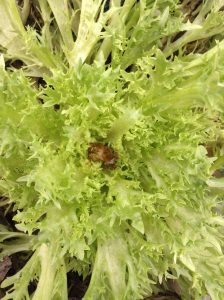Some of the red and green multi-leaf lettuce plants in Figure 1 are wilted and closer inspection reveals death and soft decay at the crown and well as freeze damage (Figure 2). Getting even closer as in Figure 3 we see white fuzzy mold and find hard black sclerotia 1/8 to ¼ inch across and up to ½ inch long at the base of the plants and in the soil. These sclerotia confirm that the plants have succumbed to white mold or lettuce drop caused by the fungus Sclerotinia sclerotiorum. The lettuce was transplanted in September or October 2016 and the photos taken in mid to late January. We continue to see more plants succumbing to the disease.
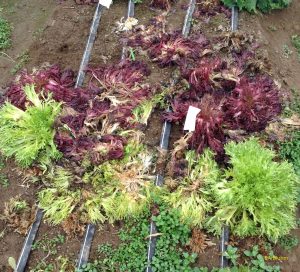
Figure 1. Lettuce in high tunnel showing symptoms of lettuce drop caused by the fungus Sclerotinia sclerotiurum. (Photo by Erin Bluhm.)
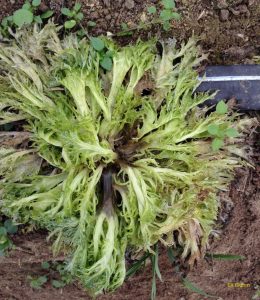
Figure 2. Soft decay in center of lettuce head with lettuce crop; freeze injury and powdery mildew are also visible. (Photo by Erin Bluhm.)
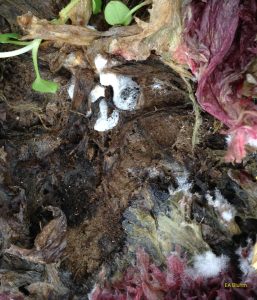
Figure 3A. White mycelieum of the fungus Sclerotinia sclerotiurum growing on lettuce tissue (Photo by Erin Bluhm.)
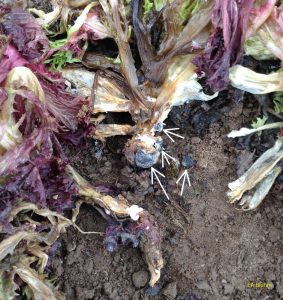
Figure 3B. Arrows mark black sclerotia of fungus Sclerotinia sclerotiurum at based of lettuce stem. Photo by Erin Bluhm.
Infection by this fungus begins when sclerotia buried in the soil produce small mushroom-like apothecia and spores from the apothecia land on susceptible plant tissue, germinate, and invade the plant. Sclerotia can also produce mycelium that can directly infect dead and dying plant material, such as dead lettuce leaves, and go on to infect heathy plant tissue. Infected areas may develop the white fuzzy mycelium of the fungus and new sclerotia form. These sclerotia can survive in the soil for several years. White mold does not spread from plant to plant except when an infected plant directly contacts an unaffected plant.
Cool temperatures (59ºF to 70ºF), wet soil and high humidity promote this disease. High soil moisture is necessary for apothecia to form. Leaf surfaces must be wet for about 48 hours in order for spores to successfully infect. These conditions are easy to find in winter high tunnels. Row covers used to raise temperature also increase humidity near the crop. In the structure where these photos were taken, poor drainage on one side of the structure could have contributed to the 10 days of high moisture conditions necessary for apothecia formation (Figure 4). Dense lettuce plantings can slow drying of surface soil after irrigation and that would also promote apothecia formation.
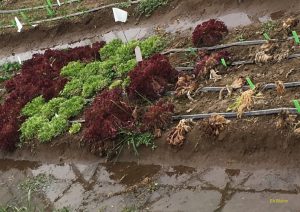
Figure 4. Water standing in alleyways can lead to saturated soil in growing beds, creating favorable conditions for disease. (Photo by Erin Bluhm.)
This disease is a concern not only for this lettuce crop, but also for other crops that may be planted in this soil. Over 360 species can be infected, but probably of most importance for many high growers are tomatoes, on which the fungus causes timber rot. The sclerotia produced on the lettuce plants can germinate later this season and infect tomatoes or other crops. The first symptom observed on tomatoes is often the wilting of scattered tomato plants. Upon closer inspection, the lower stem of an affected plant may have a light brown lesion that girdled the plant, causing it to wilt and possibly die. The lesions appear woody, which is how this disease got its alternate name: timber rot. The lesions are often accompanied by the white growth of the causal fungus as well as sclerotia. White mold may also cause a rot of tomato fruit. See https://www.extension.purdue.edu/extmedia/BP/BP-197-W.pdf for more information about the destruction this fungus can cause on tomatoes.
If conditions aren’t favorable for sclerotia to germinate they can remain dormant in the soil for long periods. If this disease is known to be present, preventive management is important. Manage soil moisture to limit long periods when soil is near saturation. Reduce relative humidity to minimize the hours stems or leaves are wet.
You may notice another problem on the lettuce: powdery mildew on lower leaves. This disease arrived in the fall and has stayed with us all winter. Of three plantings, the last planting in mid-October seemed to be the least affected.
We also observed death of growing points on lettuce in January (Figure 5). This month we observed tipburn on spinach leaves (Figure 6). It is likely that both of these are a result of calcium deficiency in the young, rapidly growing tissue. And as with other calcium disorders such blossom-end rot of tomato fruit, it is likely that environmental conditions that reduce water movement into the young leaves are a contributing factor. Young leaves in the growing point of a larger lettuce or spinach plant may be surrounded by other leaves that help to create a humid environment. When combined with the high humidity under a row cover found in winter high tunnel production, the humidity may be so high that little water transpires from the leaves and so little water is drawn into the leaves from the soil. As a result, calcium, which moves with water into the plant, is also not drawn into the young leaves and the rapidly developing tissue becomes deficient, resulting in death of the growth point, or leaf margins, which causes tipburn. If soil moisture was low at a time of high demand, that would exacerbate the problem.
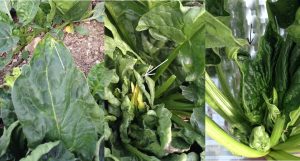
Figure 6. A. Death of spinach leaf tip or ‘tipburn’ can begin when young leaf is still expanding (arrows in B, C). (Photo by Liz Maynard)
A first step in addressing these problems is to assure that soil calcium levels are adequate and uptake by the plants is not hindered by excess of other cations such as magnesium or potassium. A soil test will help to determine if that is the case and appropriate amendments added as needed. But even if soil levels are reasonable the problems can occur under conditions of high humidity or inadequate water supply described above. With these factors in mind, other potential solutions would be to reduce humidity around the plants by adjusting management of row covers and ventilation, reducing plant density, or altering planting arrangement to create better air flow.
Dan Egel contributed to this article.
